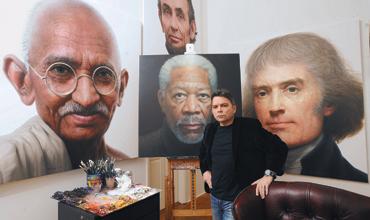When U.S. Secretary of State John Kerry makes his first visit to India in June, he will present a portrait of Mahatma Gandhi to Indian Prime Minister Manmohan Singh.
The painting is one of the most recent creations of Atlanta artist Ross Rossin. Lifelike portraits cover the walls of the Bulgarian-American artist’s Buckhead studio. Most who see the paintings would mistake them for photographs. It’s only when they are viewed really close that certain brush strokes show.
The artist has painted more than 500 portraits, ranging from Abraham Lincoln to film icon Audrey Hepburn. (See Pages 24A-25A.)
For Rossin, who has called Atlanta home since 2001, paintings like that of Gandhi have become a bridge between Atlanta and the world.
“I want to share with the world, not only India, how relevant and inspiring Gandhi’s ideas were and continue to be,” Rossin said.
R.K. Sehgal, chairman of SFC Energy and former commissioner of what’s now the Georgia Department of Economic Development, took India’s Consul-General of Atlanta Ajit Kumar to see the painting.
“He said he has seen hundreds of paintings and busts of Gandhi, but never one like this,” Sehgal said.
This gift will further strengthen the relationship between Georgia and India, he said.
Rossin’s portrait of British monarch King George VI was presented to Queen Elizabeth II last year on behalf of the people of Georgia on the occasion of her Diamond Jubilee (60 years on the throne). It is highly unusual for the British royal family to accept gifts, saidAnabelle Malins, British Consul-General in Atlanta. But an exception was made and the queen asked for the portrait to remain in Georgia for public display.
“The fact that the portrait was accepted, acknowledged how much — from the royal family’s end — the continuing relationship with the U.S. and Georgia means to the U.K.,” Malins said.
Rossin said he was inspired to paint the monarch after watching the 2010 film“The King’s Speech.”
“I was intrigued by the persona of the king. He wasn’t meant to be king, but rose to the occasion when duty called,” he said.
Rossin has also achieved national acclaim. Two of his portraits, of AmbassadorAndrew Young and baseball legend Hank Aaron, have been accepted by the Smithsonian National Portrait Gallery in Washington, D.C., having made the cut through the Smithsonian’s rigorous selection process. He intends to submit another, of Maya Angelou, which he is currently working on.
Of the portraits that are not commissioned — such as the ones of Gandhi and King George VI — Rossin said he selects his subjects on instinct.
“Each painting allows me to experience a person in an intimate way.” For living subjects, Rossin takes about 60 photographs, and is able to conceptualize “within three to five minutes,” how he will paint the portrait. He works off the photographs, or if he’s painting an iconic deceased figure, from old photographs. “I don’t need their physical presence. What I care about is about capturing what’s inside their soul,” he said.
“People say things to me without opening their mouth.”
After that, it takes him an average of six weeks to complete a portrait, and he typically paints two or three different pieces at the same time.
“I like to paint each layer with a fresh perspective,” he said.
His portraits are in the style of classical oil paintings, built from layers upon layers of paint. He finishes them with details that bring a 3-D quality to each painting, whether it’s the moisture glistening inMorgan Freeman’s eyes or the small crease in the suits of the 18 U.S. 20th century presidents depicted in Rossin’s 13-by-20 foot masterpiece “A Meeting in Time.”
A vast majority of Rossin’s portraits are commissioned for between $22,000 and $90,000, depending on size and style. His business partner, Karen Hudson, spoke to the challenges of keeping his artwork accessible to the market. “Of course there are people who will pay much more for a commissioned portrait, but we don’t want to lose the market we currently have,” she said. As well as painting iconic figures, Rossin gets commissions for private collections. “Even paintings he does for his own collection usually end up somewhere else,” she said.
When asked who is the most inspiring person he’s ever re-created on canvas, Rossin hesitated, then said AmbassadorAndrew Young counts among his top five favorite paintings, both for its professional and personal significance. Young’s portrait was the first of Rossin’s portraits donated to the Smithsonian in 2011, and is displayed in its permanent collection in Washington.
He counts Young as a personal friend, and said: “I’m inspired and enriched by him. I’ve learned so much from his views of the world.”
Capturing Young’s “goodness” and “positive energy” was intrinsic to the portrait, he said.
“I’m obsessed with the idea of how my work will be accepted in 200 years … By then, we will all be long gone, but these portraits will remain,” he said. In fact, it’s this notion that drives every portrait he paints. “I always imagine, what message will these paintings convey in 200 years? What energy will people see in it?”
He has painted controversial figures — such as Zimbabwean President Robert Mugabe. Rossin said he saw a man with “strong convictions” when he painted him. So far Rossin has not been commissioned to paint someone he’s had to refuse, but said he would never paint dictators likeAdolf Hitler or Pol Pot.
Although Rossin has traveled to and lived around the world, he said he can’t see himself moving out of Atlanta any time soon. “Atlanta is one of the best-kept secrets in the United States.” He also balked at being associated with the “artist’s life” and said “about 98 percent” of his friends are not artists. “I embrace humanity in all of its varieties.”
But he admits art takes up all his time.
“When I’m not painting, I’m sketching,” he added.
Living in Atlanta has allowed Rossin to experience “all the diversity in humanity,” he said.
“I’m an artist from Eastern Europe and Ambassador Young is an African-American civil rights and political leader. If you think about it, we have very little in common, but actually we are quite similar,” he said. “We both care about humanity and beauty. We share a lot of philosophies.”
“He is an artist with remarkable talent. The King George VI portrait arrests me every time I walk past it,” added British Consul-General Malins. “It’s so human.”
Despite his extraordinary talent, Rossin said, “I’m not a scholar. I gather just enough information as I need about a person, but I need my own opinion and angle when I paint them,” he said.
He connects to each person through his own experience, which he said comes from seeing different political systems and experiencing “life” through emotions ranging from disappointment to love.
“I use my experience to interpret a person. Each portrait is also a self -portrait.”

